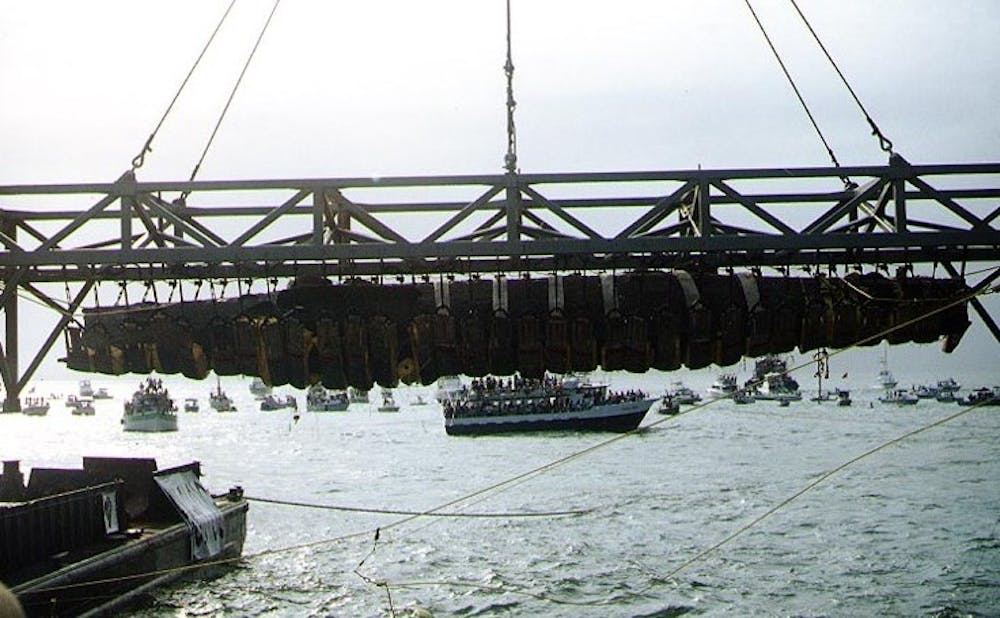According to research by a Duke alumna, the eight Confederate soldiers onboard the H.L. Hunley—the world’s first submarine to sink an enemy warship—were killed by the submarine’s own weapon.
In February 1864, the Hunley sank the USS Housatonic—a Union ship—in less than five minutes, using 135 pounds of black powder. Although the Hunley became the first submarine to sink an enemy warship, all eight crew members on board were killed. Researchers have since struggled to find an answer as to why, despite the discovery of the submarine’s remains in 1995.
However, Rachel Lance—a former Ph.D. student in the department of biomedical engineering—performed explosive experiments on a scale model and found that the shockwave from the Hunley's own weapon killed the crew.
“It answers this question that has still been lingering about this story that occurred,” said Lance, who wrote the paper as part of her dissertation for her Ph.D. program last year.
In the past, researchers had been puzzled by the fact that the eight crew members had no broken bones and the submarine was mostly intact, which suggested that the crew members made no attempt to escape. The predominant speculation was that the crew drowned or suffocated to death.
Lance and her research team conducted a series of experiments to address this longstanding mystery. As a big history buff who is also in the U.S. Navy, Lance had been studying the effects of underwater explosives on unprotected swimmers and was intrigued by its application to the Hunley.
Although she lacked access to the actual submarine, Lance used a scale model of the Hunley that she built. Lance said that she believes the results would not have been different even with the actual submarine.
“You can perform explosive experiments by scaling them down in size and we blasted the scale model in two different ways," Lance explained.
The first experiment used compressed gas to simulate the effects of the explosions without using actual live explosion. Subsequently, scaled black powder charges were used.
After placing the model submarine in a pond and exposing it to scaled-down charges based on ones the actual Hunley would have used, Lance then measured the pressures inside the submarine and outside in the water. The pressures allowed Lance to calculate how much of the blast was being transmitted across the water.
According to her results, the torpedo used by the Hunley exploded while it was underwater. Since water transmits blasts well, the pressure wave from the explosion was transmitted to the hull of the boat.
Crucially, and unlike modern submarines, the Hunley had a remarkably thin hull, which proved fatal for the crew within.
“[The pressure wave] caused a really sharp, really fast deformation in that hull. And that little motion was enough to create a secondary pressure wave inside the boat,” Lance said. “That secondary pressure wave inside the boat was of sufficient amplitude that it would’ve caused lethal blast traumas to the crew inside.”
Lance said that the blast injuries would have caused immediate fatal lung trauma, also known as “blast lung,” which could explain the lack of apparent injuries on the crew’s skeletons.
Although Navy researchers involved with the official examination of the Hunley expressed doubts about her blast wave theory, Lance noted her carefulness in taking the measurements from confirmed sources and using multiple reference points.
“There were two measurements that really mattered,” Lance said. “The first one was the thickness of the hull, which had been published in multiple sources. And the second one was the distance from the charge, which was very evident from the fact of where the remains of the charges were found.”
The research received monetary support from a variety of sources—including the Josiah Charles Trent Memorial Foundation Endowment Fund at Duke University, the Department of Defense SMART Scholarship Program, the US Army MURI program and an Exploratory Research Grant from the Hagley Library’s Center for the History of Business, Technology and Society.
“[The Hunley is the] only case study of people having [a] fatal blast injury while inside a vessel, or a protected vehicle, and it proves that this phenomenon is possible,” Lance said.
Get The Chronicle straight to your inbox
Signup for our weekly newsletter. Cancel at any time.

